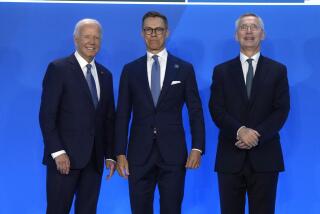U.S., Soviets Ink Pact for Film Projects
- Share via
MOSCOW — American film makers reached a long-sought agreement with Soviet authorities here on Wednesday that will bring many more American movies to the Soviet Union.
Jack J. Valenti, president of the Motion Picture Assn. of America, which represents the eight largest U.S. film companies, said that Goskino, the Soviet State Committee for Cinematography, had agreed on broad guidelines that will give the American companies great flexibility when they negotiate terms for each film or package of films to be shown here.
“American producers will be able to have the whole wide spectrum of alternatives on how they license films to be shown in the Soviet Union,” Valenti said.
This means that they will be able to accept partial payment in Soviet currency, perhaps for older films, and to use those funds to finance local projects, such as theater rental or the shooting of new films on Soviet locations.
This, in turn, will make it possible to be paid in hard currency for more recent films in greater demand.
Until now, relatively few American films were shown in the Soviet Union because of the difficulty in negotiating terms for their distribution here and in agreeing on payment. Only rarely was the Soviet Union willing to pay license fees in foreign currencies, but American companies had little use for Soviet rubles.
The agreement also provides a framework for U.S. companies to film in the Soviet Union and for a variety of Soviet-American co-productions, Valenti said. American film makers also promised to help bring more Soviet films to the United States.
“The prospects for filming and co-productions in the Soviet Union are exciting for us,” Charles W. Fries, chairman and president of Fries Entertainment Inc., a producer of television movies and miniseries, said of the new agreement.
“Now that we have a system for distribution of our films and for payment, there will be a real incentive for us to work here. . . .
“The Soviet Union has new and interesting backgrounds for us. There is great openness here to co-productions with American companies. And the American film industry will be able to take advantage of more reasonable production costs and a great deal of creative talent we can tap.”
Fries offered Gostelradio, Soviet State Committee for Television and Radio, four of his company’s television movies or series without charge to encourage interest in acquiring the rights to others.
“We are at the threshold of something important, so let’s encourage it,” he said later.
Another agreement provides for copyright protection for American films in the Soviet Union and Soviet films in the United States.
The agreements were also signed by the American Film Marketing Assn., which represents 98 film companies in the international export market. Full details will be made public Monday in Los Angeles, Valenti said.
After 22 years of negotiations with Soviet authorities on these issues, “this is the first time I am leaving Moscow with a signed document of agreement where individual American film companies can come to the Soviet Union and Goskino (the State Committee for Cinematography) can go to the United States,” Valenti said.
The agreements were reached during three days of talks between representatives of the U.S. and Soviet government information agencies, the news media and the entertainment industries in the second of a series of planned meetings aimed broadly at breaking down stereotyped “enemy images” that the two countries have of one another and at improving communications between them.
Another major agreement reached was the establishment of a special working group to deal directly and immediately, case by case, with charges of “disinformation,” the misleading propaganda that Washington and Moscow allege that each puts out about the other.
“Both sides will avoid actions that will be judged by the other side as disinformation or misinformation, either deliberately or otherwise,” Valentin M. Falin, the chairman of Novosti Press Agency and the leader of the Soviet delegation, said of the accord.
Falin also announced the immediate opening of a news bureau for the Voice of America--and the new correspondent was accredited on the spot, a procedure that often takes six months.
The 68-member American delegation was led by Charles Z. Wick, director of the U.S. Information Agency, and included representatives from newspapers, magazines, book publishing, theatrical agencies, radio and television. The Soviet delegation was composed of 107 representatives from similar organizations, although most are state-controlled.
The delegations also reported making some progress on arrangements for the sale of U.S. newspapers and magazines on Soviet newsstands for local currency, on improving working conditions for American and Soviet news correspondents, and on joint international television broadcasts between the U.S. government’s Worldnet satellite and the Soviet State Committee Television and Radio.
More to Read
The biggest entertainment stories
Get our big stories about Hollywood, film, television, music, arts, culture and more right in your inbox as soon as they publish.
You may occasionally receive promotional content from the Los Angeles Times.










